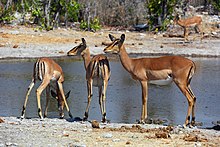
The aardvark is a medium-sized, burrowing, nocturnal mammal native to Africa. It is the only living species of the order Tubulidentata, although other prehistoric species and genera of Tubulidentata are known. Unlike most other insectivores, it has a long snout, similar to that of a pig, which is used to sniff out food.

Kingfishers are a family, the Alcedinidae, of small to medium-sized, brightly coloured birds in the order Coraciiformes. They have a cosmopolitan distribution, with most species living in the tropical regions of Africa, Asia, and Oceania, but also can be seen in Europe. They can be found in deep forests near calm ponds and small rivers. The family contains 116 species and is divided into three subfamilies and 19 genera. All kingfishers have large heads, long, sharp, pointed bills, short legs, and stubby tails. Most species have bright plumage with only small differences between the sexes. Most species are tropical in distribution, and a slight majority are found only in forests.

A nest is a structure built for certain animals to hold eggs or young. Although nests are most closely associated with birds, members of all classes of vertebrates and some invertebrates construct nests. They may be composed of organic material such as twigs, grass, and leaves, or may be a simple depression in the ground, or a hole in a rock, tree, or building. Human-made materials, such as string, plastic, cloth, or paper, may also be used. Nests can be found in all types of habitat.

The ground pangolin, also known as Temminck's pangolin, Cape pangolin or steppe pangolin is a species of pangolin from genus Smutsia of subfamily Smutsiinae the within family Manidae. It is one of four species of pangolins which can be found in Africa, and the only one in southern and eastern Africa. The animal was named for the Dutch zoologist Coenraad Jacob Temminck.
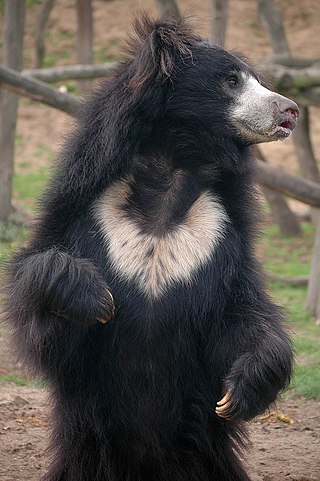
The sloth bear, also known as the Indian bear, is a myrmecophagous bear species native to the Indian subcontinent. It feeds on fruits, ants and termites. It is listed as vulnerable on the IUCN Red List, mainly because of habitat loss and degradation. It is the only species in the genus Melursus.

Scavengers are animals that consume dead organisms that have died from causes other than predation or have been killed by other predators. While scavenging generally refers to carnivores feeding on carrion, it is also a herbivorous feeding behavior. Scavengers play an important role in the ecosystem by consuming dead animal and plant material. Decomposers and detritivores complete this process, by consuming the remains left by scavengers.
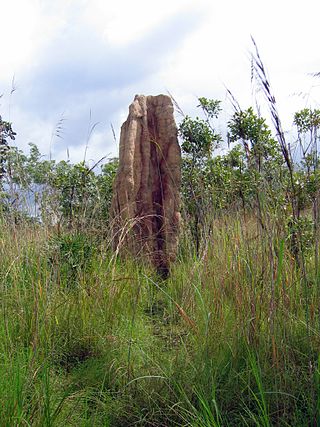
Mound-building termites are a group of termite species that live in mounds which are made of a combination of soil, termite saliva and dung. These termites live in Africa, Australia and South America. The mounds sometimes have a diameter of 30 metres (98 ft). Most of the mounds are in well-drained areas. Termite mounds usually outlive the colonies themselves. If the inner tunnels of the nest are exposed it is usually dead. Sometimes other colonies, of the same or different species, occupy a mound after the original builders' deaths.

The short-beaked echidna, also known the short-nosed echidna, is one of four living species of echidna and the only member of the genus Tachyglossus.

The Indian pangolin, also called thick-tailed pangolin and scaly anteater, is a pangolin native to the Indian subcontinent. Like other pangolins, it has large, overlapping scales on its body which act as armour. The colour of its scales varies depending on the colour of the earth in its surroundings. It can also curl itself into a ball as self-defence against predators such as the tiger. It is an insectivore feeding on ants and termites, digging them out of mounds and logs using its long claws, which are as long as its fore limbs. It is nocturnal and rests in deep burrows during the day.
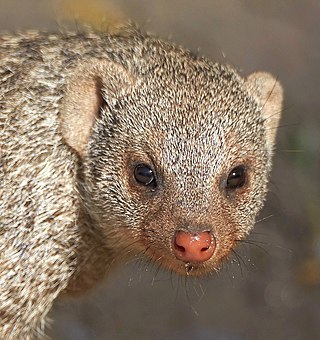
The banded mongoose is a mongoose species native from the Sahel to Southern Africa. It lives in savannas, open forests and grasslands and feeds primarily on beetles and millipedes. Mongooses use various types of dens for shelter including termite mounds. While most mongoose species live solitary lives, the banded mongoose live in colonies with a complex social structure.
Economic entomology is a field of entomology, which involves the study of insects that benefit or harm humans, domestic animals, and crops. Insects that pose disadvantages are considered pests. Some species can cause indirect damage by spreading diseases, and these are termed as disease vectors. Those that are beneficial include those that are reared for food such as honey, substances such as lac or pigments, and for their role in pollinating crops and controlling pests.

Cannibalism is the act of consuming another individual of the same species as food. Cannibalism is a common ecological interaction in the animal kingdom and has been recorded in more than 1,500 species. Human cannibalism is well documented, both in ancient and in recent times.

The common dwarf mongoose is a mongoose species native to Angola, northern Namibia, KwaZulu-Natal in South Africa, Zambia and East Africa. It is part of the genus Helogale, along with the Ethiopian dwarf mongoose.
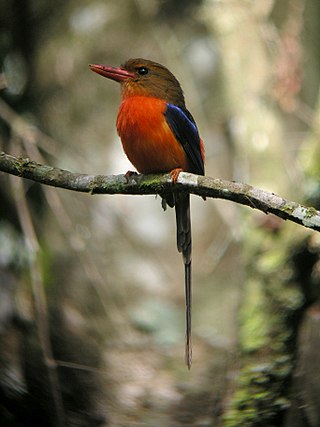
The paradise kingfishers are a group of tree kingfishers endemic to New Guinea — with the exception of two species also present in the Moluccas and Queensland.

Wild Africa is a British nature documentary series created and produced by the BBC. It explores the natural history of the African continent. It was first transmitted on 7 November 2001 on BBC Two in the United Kingdom and comprises six episodes. Each concentrates on a particular environment. The producers use aerial photography and wildlife footage to show how natural phenomena such as seasonal changes influence the patterns of life. Wild Africa was produced by the BBC Natural History Unit and narrated by Fergal Keane.

Tool use by non-humans is a phenomenon in which a non-human animal uses any kind of tool in order to achieve a goal such as acquiring food and water, grooming, combat, defence, communication, recreation or construction. Originally thought to be a skill possessed only by humans, some tool use requires a sophisticated level of cognition. There is considerable discussion about the definition of what constitutes a tool and therefore which behaviours can be considered true examples of tool use. A wide range of animals, including mammals, birds, fish, cephalopods, and insects, are considered to use tools.

Trichomonas gallinae is a cosmopolitan parasite of birds including finches, pigeons, doves, turkeys, chickens, parrots, raptors. The condition in birds of prey is called frounce. It is believed to be an ancient pathogen causing frounce-like symptoms in theropod dinosaurs. The same condition in pigeons is commonly called canker.

Structures built by non-human animals, often called animal architecture, are common in many species. Examples of animal structures include termite mounds, ant hills, wasp and beehives, burrow complexes, beaver dams, elaborate nests of birds, and webs of spiders.

Digging, also referred to as excavation, is the process of using some implement such as claws, hands, manual tools or heavy equipment, to remove material from a solid surface, usually soil, sand or rock on the surface of Earth. Digging is actually the combination of two processes, the first being the breaking or cutting of the surface, and the second being the removal and relocation of the material found there. In a simple digging situation, this may be accomplished in a single motion, with the digging implement being used to break the surface and immediately fling the material away from the hole or other structure being dug.

Pursuit predation is a form of predation in which predators actively give chase to their prey, either solitarily or as a group. It is an alternate predation strategy to ambush predation — pursuit predators rely on superior speed, endurance and/or teamwork to seize the prey, while ambush predators use concealment, luring, exploiting of surroundings and the element of surprise to capture the prey. While the two patterns of predation are not mutually exclusive, morphological differences in an organism's body plan can create an evolutionary bias favoring either type of predation.
